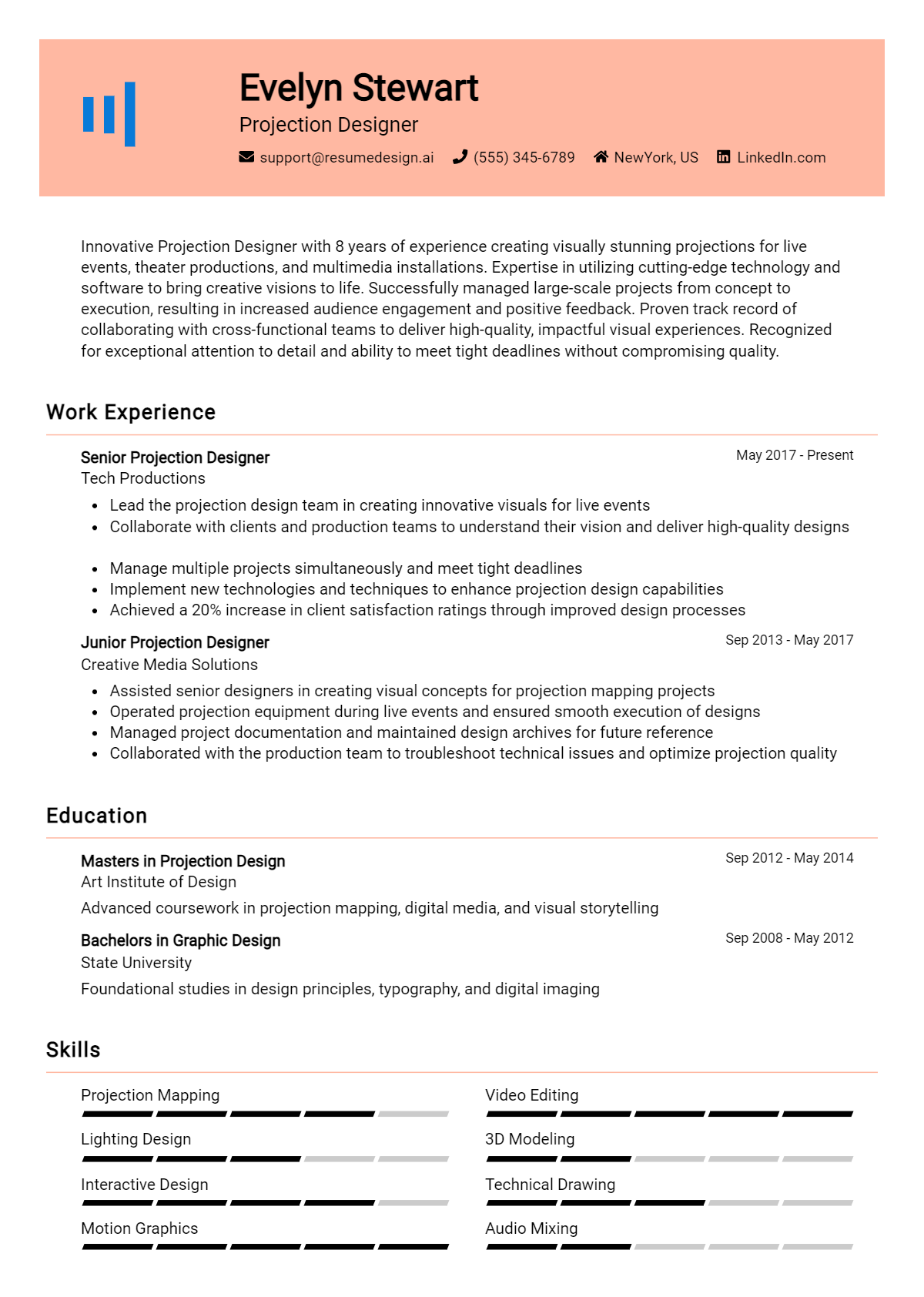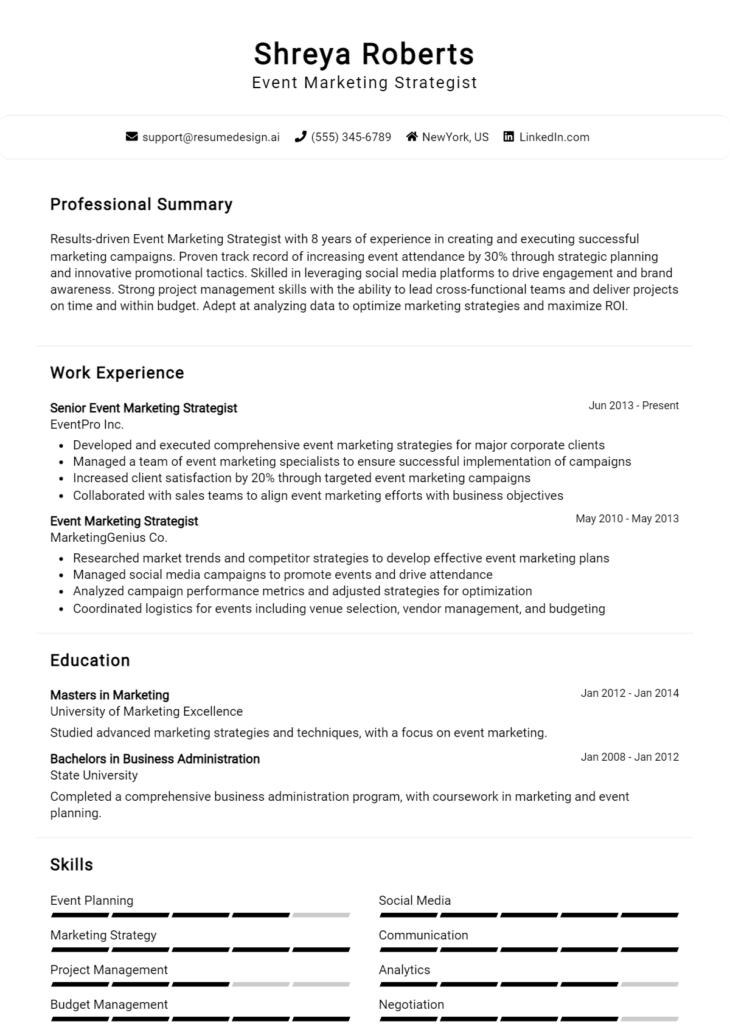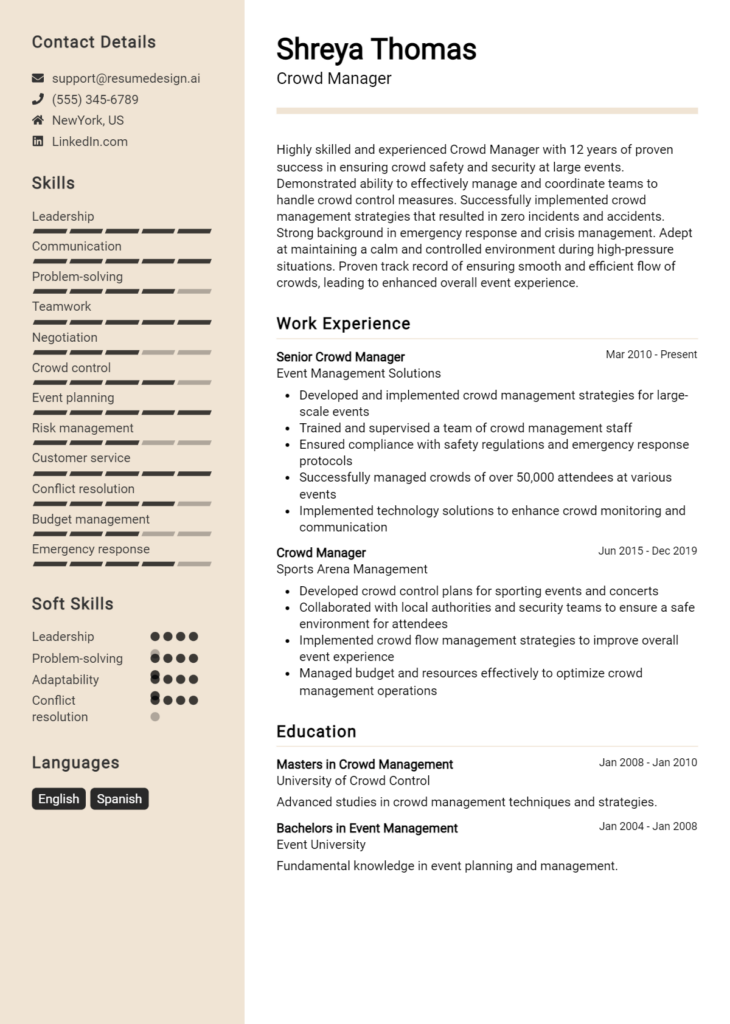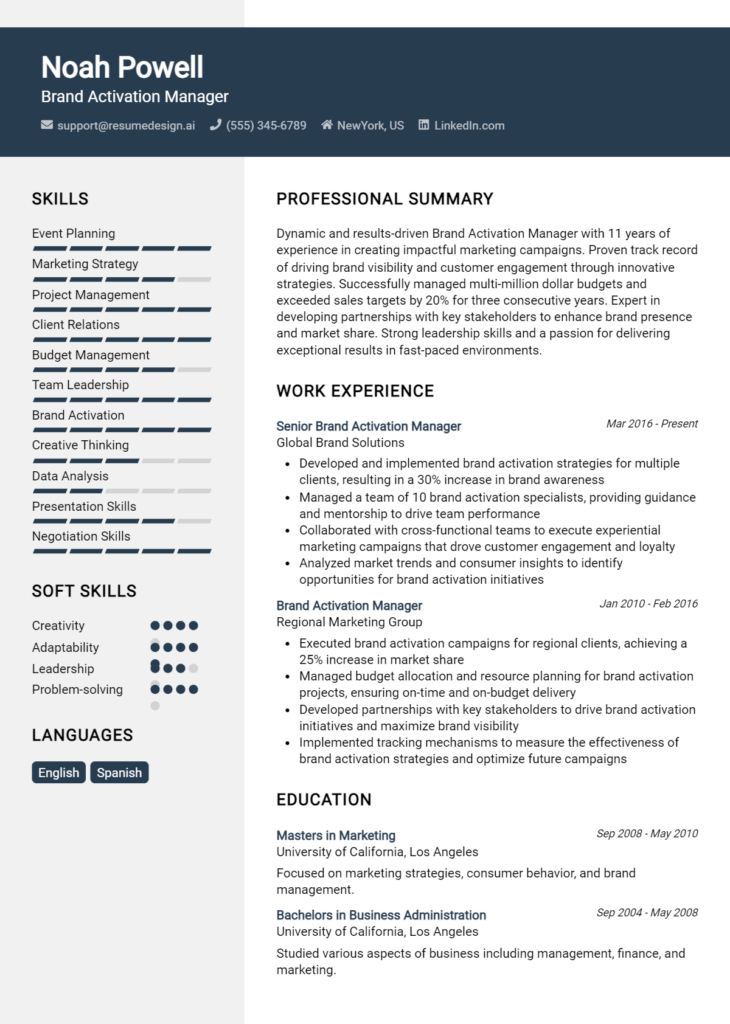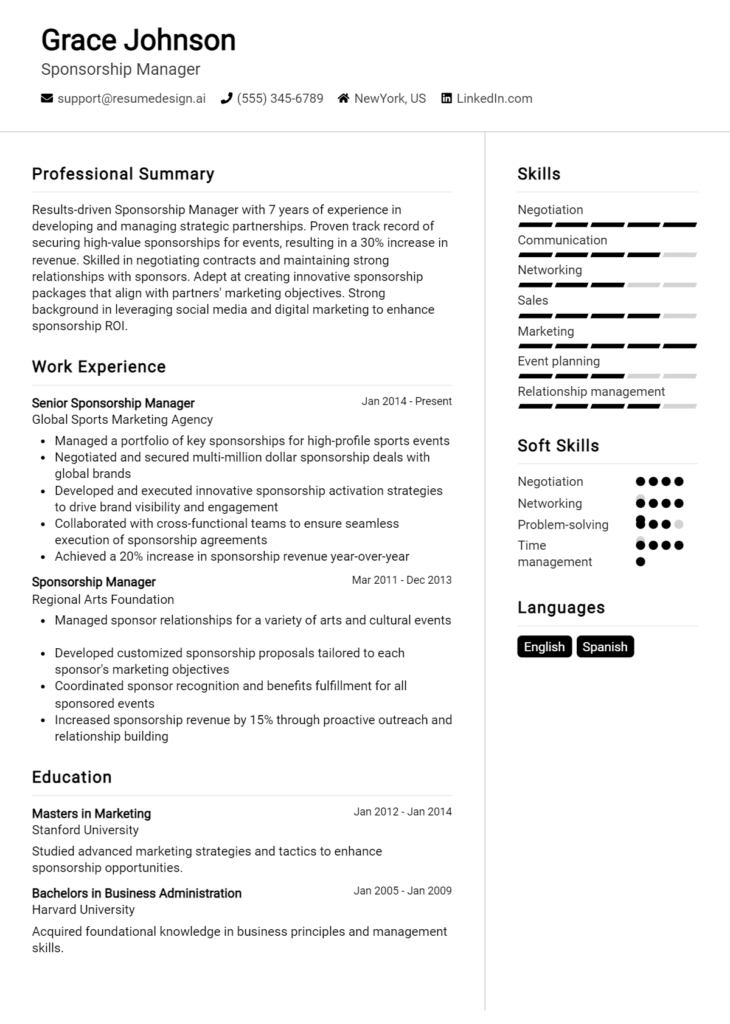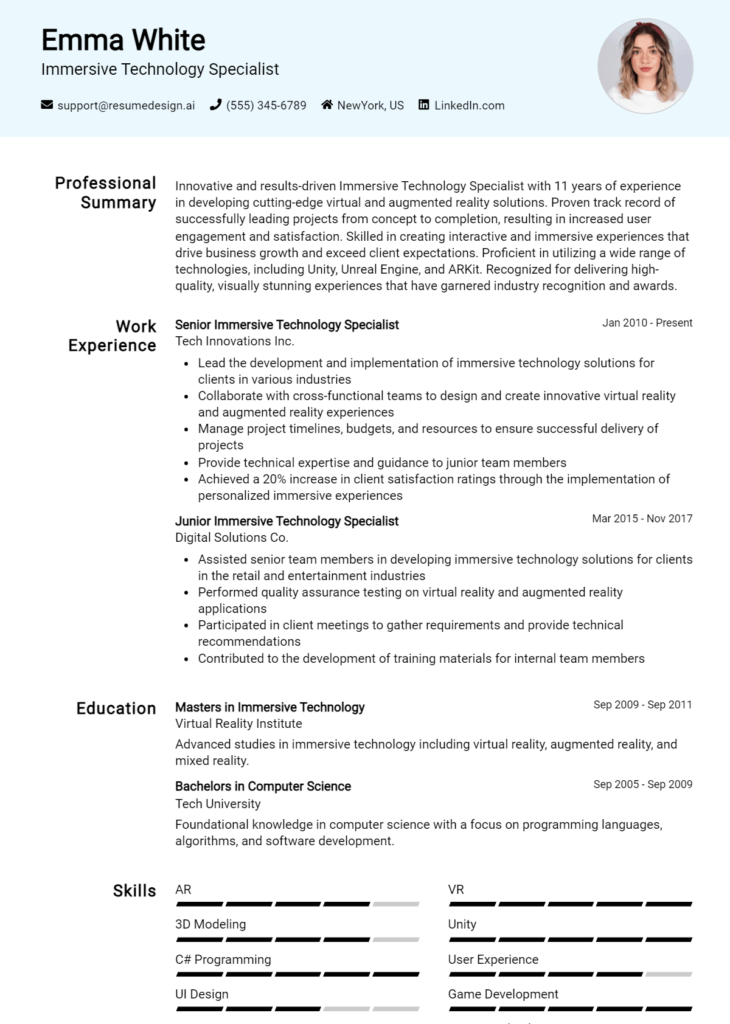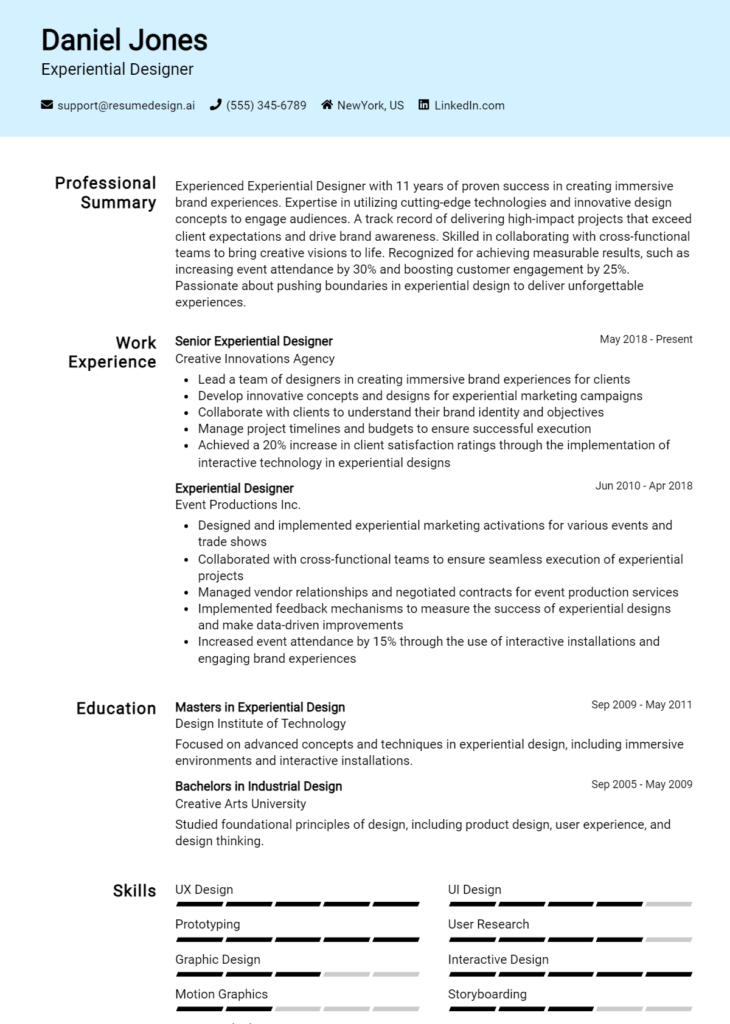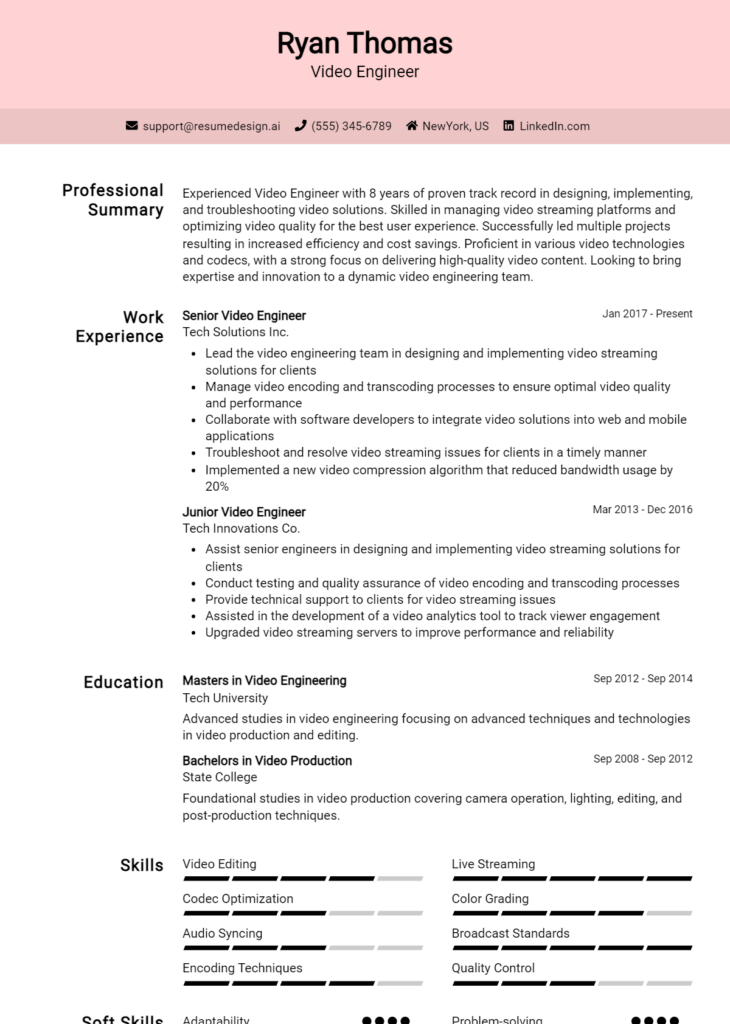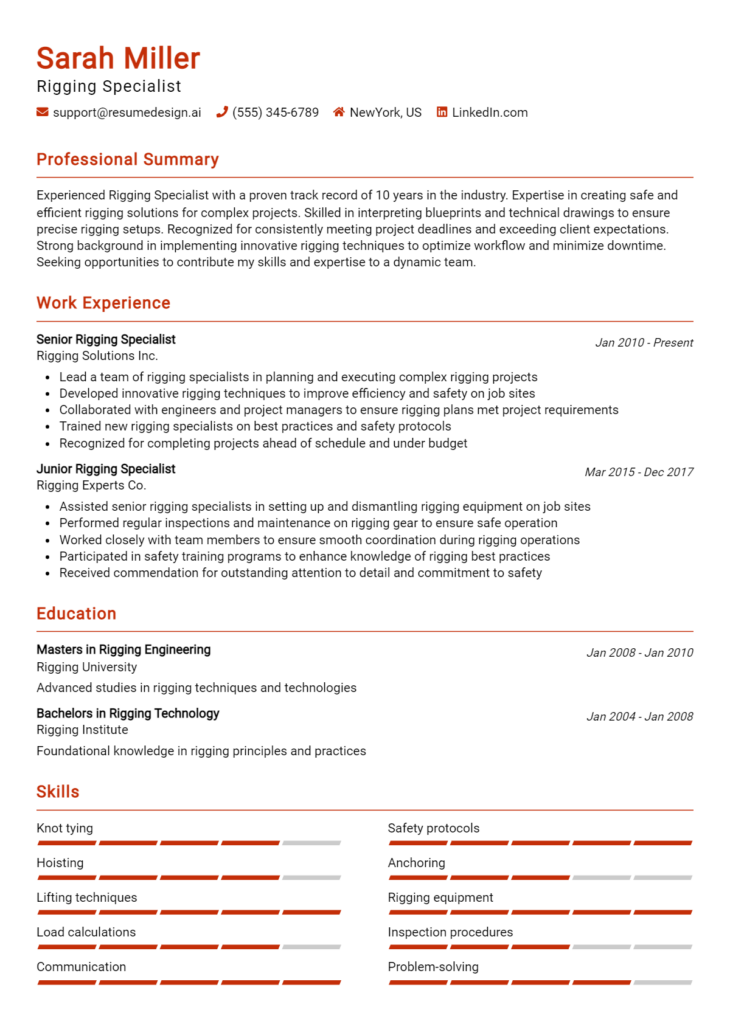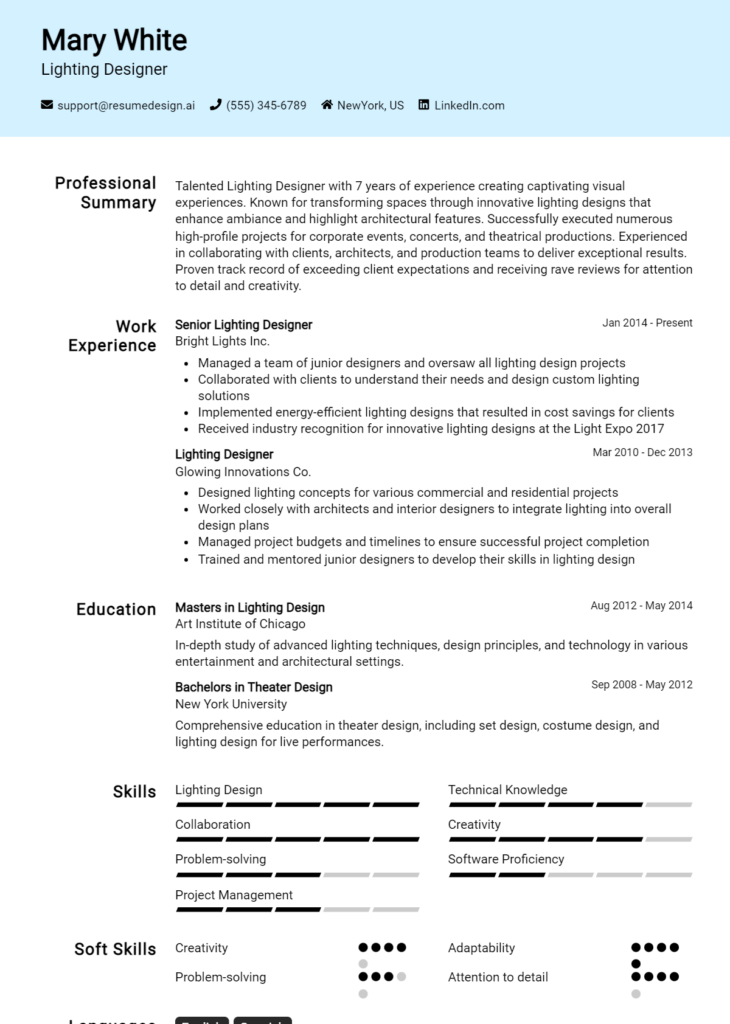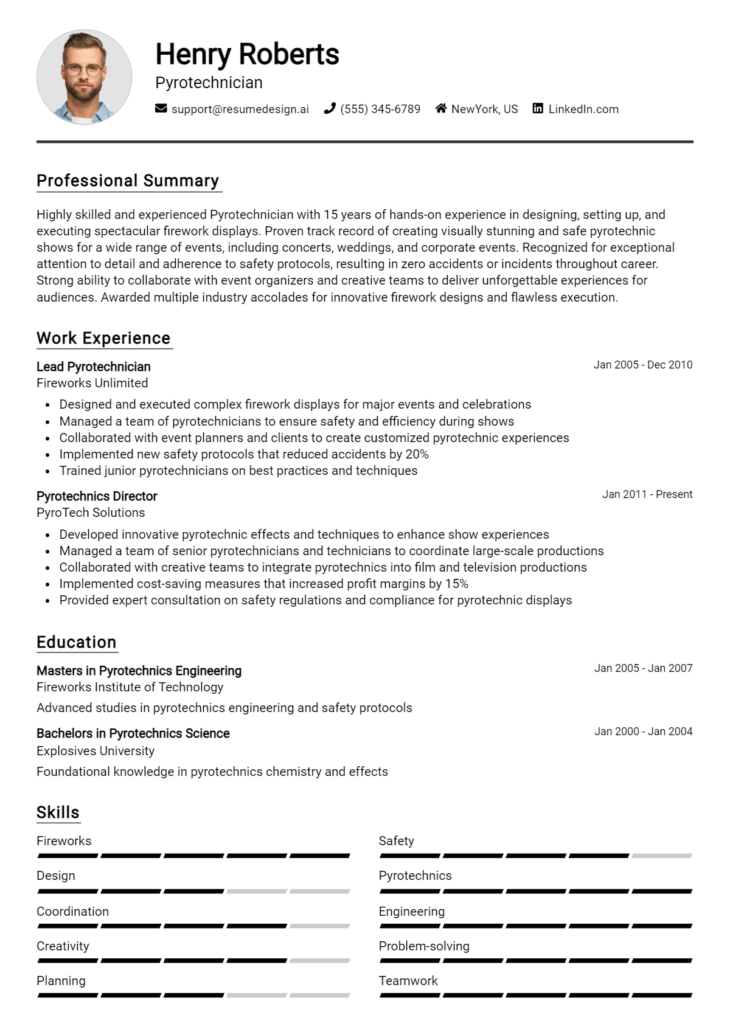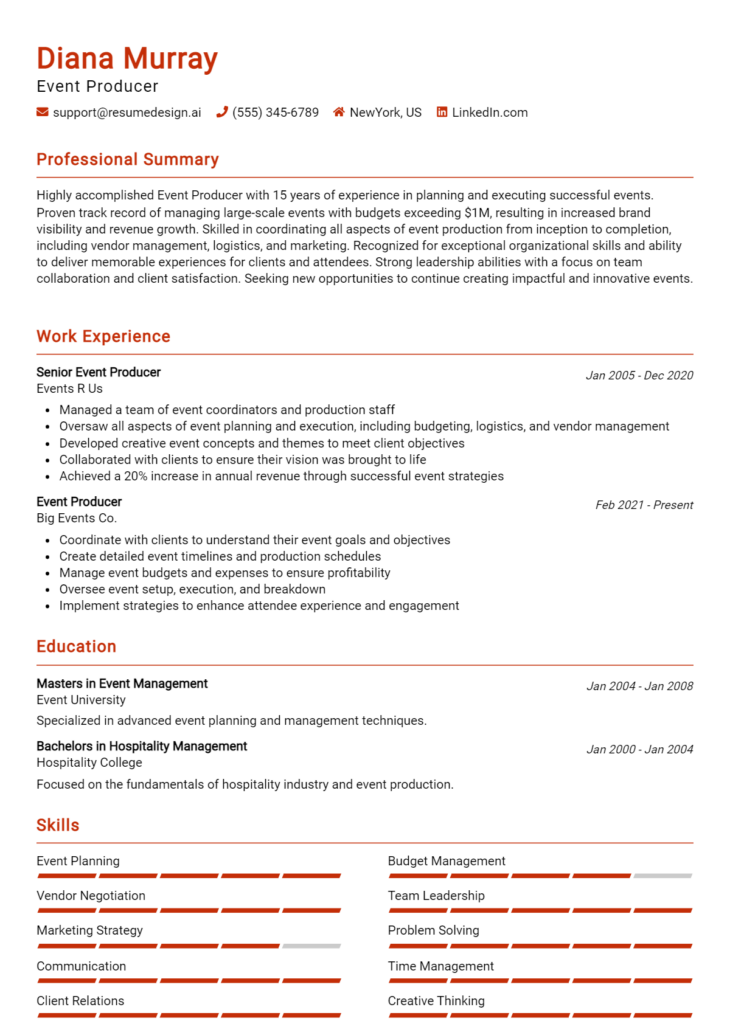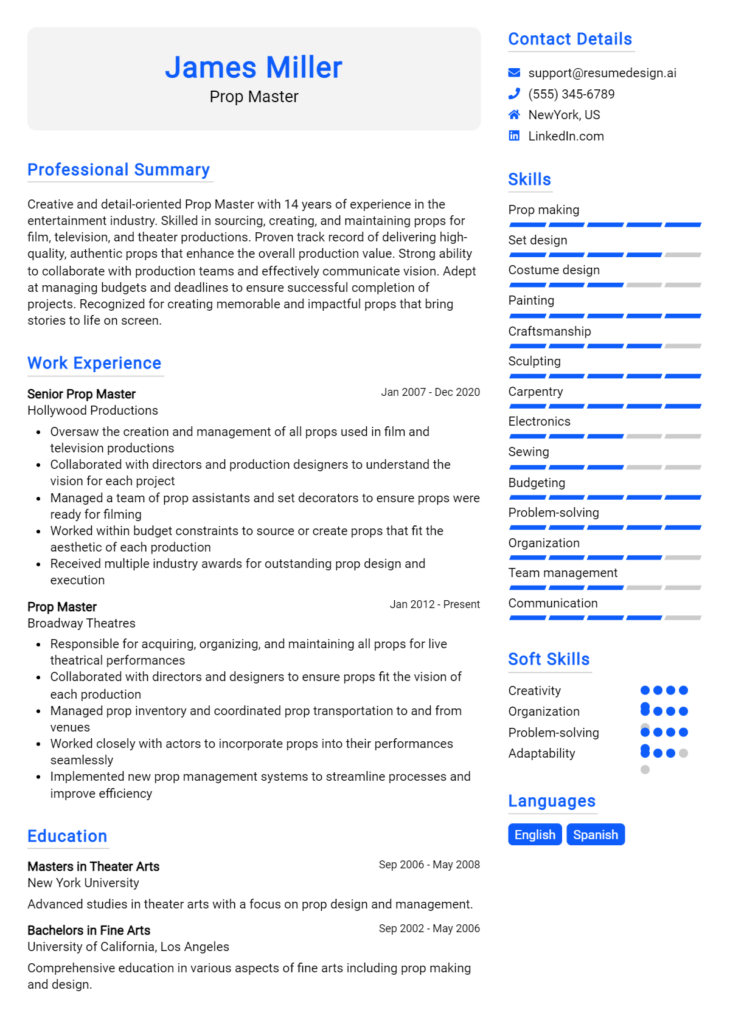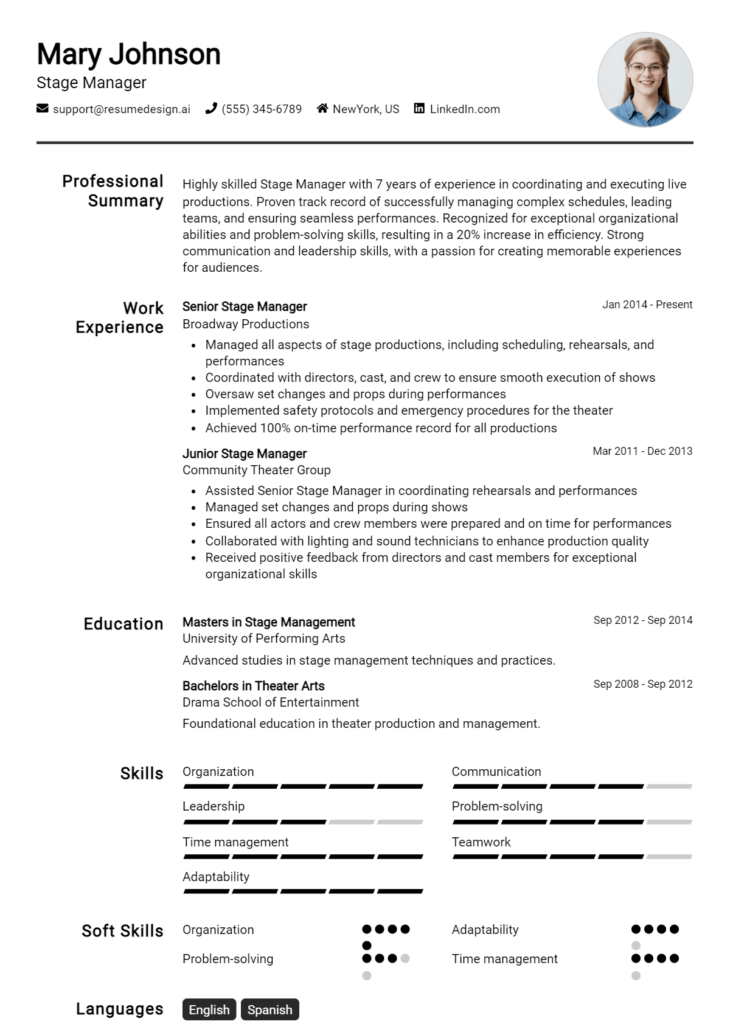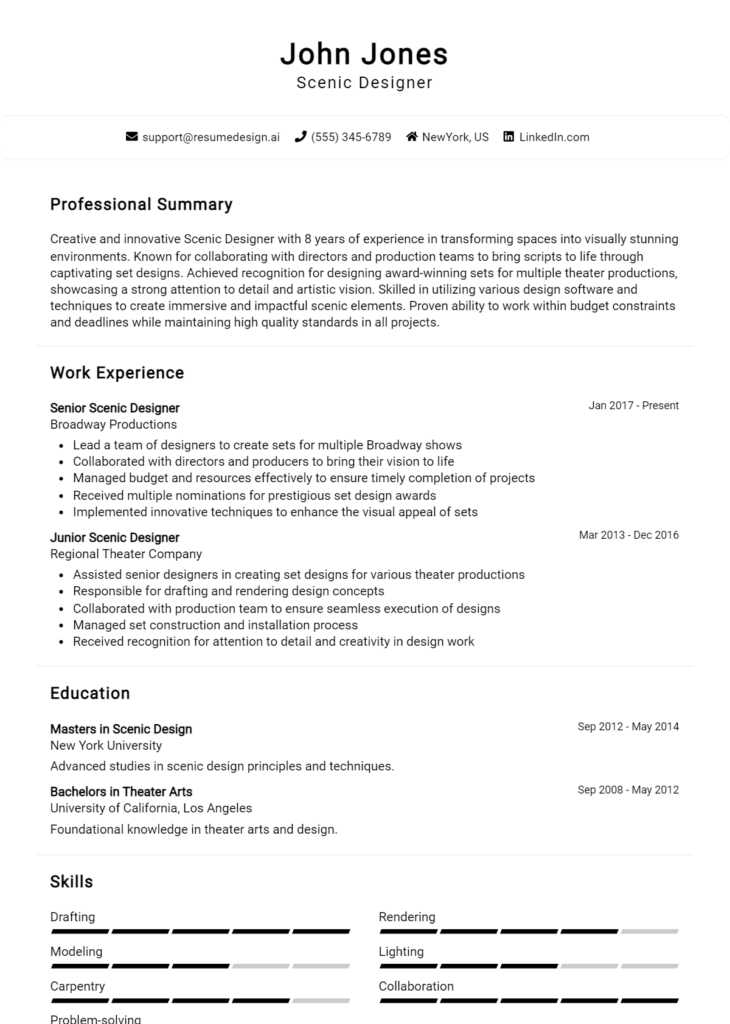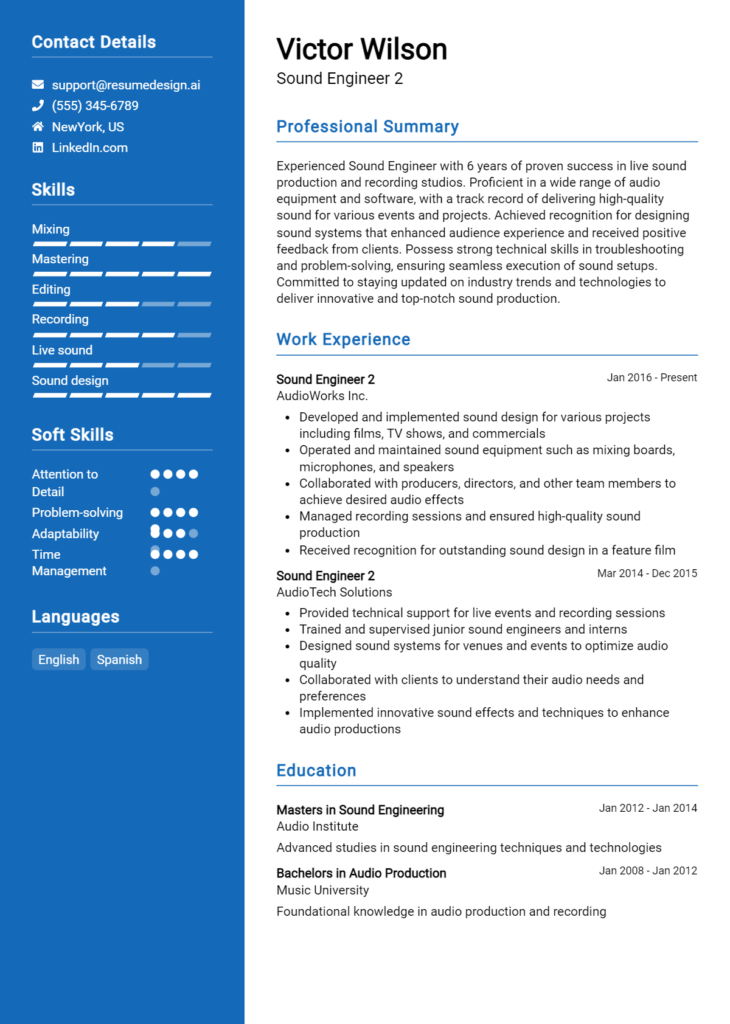Projection Designer Core Responsibilities
A Projection Designer plays a vital role in bridging various departments, such as creative, technical, and production teams, to create impactful visual experiences. Key responsibilities include conceptualizing and executing projection designs, collaborating with directors and designers, and managing technical equipment. Essential skills encompass technical expertise in projection technology, strong creative problem-solving, and effective communication. These abilities are crucial for achieving organizational goals, and a well-structured resume can effectively highlight these qualifications, ensuring candidates stand out in the competitive job market.
Common Responsibilities Listed on Projection Designer Resume
- Develop and execute innovative projection designs for live events and installations.
- Collaborate with creative teams to align visual concepts with project goals.
- Set up and operate projection equipment during rehearsals and performances.
- Conduct technical rehearsals to ensure seamless integration of visuals.
- Manage and troubleshoot projection systems in real-time.
- Research and implement new projection technologies and techniques.
- Maintain and organize projection equipment and software.
- Assist in the creation of storyboards and visual presentations.
- Communicate effectively with various departments to ensure project success.
- Document and report on technical requirements and processes.
- Train and mentor junior projection staff as necessary.
High-Level Resume Tips for Projection Designer Professionals
In the competitive field of projection design, a well-crafted resume serves as your first opportunity to make a lasting impression on potential employers. It is your chance to showcase not only your technical skills and artistic vision but also to highlight your achievements and unique contributions to past projects. A thoughtfully designed resume can effectively communicate your expertise, creativity, and professional journey, making it crucial for standing out in a crowded job market. This guide will provide practical and actionable resume tips specifically tailored for Projection Designer professionals, helping you present yourself in the best light possible.
Top Resume Tips for Projection Designer Professionals
- Tailor your resume to match the job description, using relevant keywords and phrases to catch the employer's attention.
- Showcase your relevant experience by listing specific projects and collaborations that demonstrate your expertise in projection design.
- Quantify your achievements wherever possible, such as the scale of events you've worked on or the number of projects completed successfully.
- Highlight industry-specific skills, such as proficiency in software like QLab, MadMapper, or other projection mapping tools.
- Include a strong portfolio link that showcases your best work and demonstrates your creative range.
- Utilize a clean and professional format that emphasizes readability and makes it easy for employers to find key information quickly.
- Incorporate testimonials or quotes from previous clients or collaborators to add credibility to your experience.
- Keep your resume concise, ideally one page, focusing on the most relevant and impactful information.
- Showcase your adaptability and willingness to learn new technologies or techniques in the constantly evolving field of projection design.
By implementing these tips into your resume, you can significantly increase your chances of landing a job in the Projection Designer field. A well-structured and compelling resume not only highlights your skills and achievements but also demonstrates your professionalism and dedication to your craft, ultimately making you a more attractive candidate to potential employers.
Why Resume Headlines & Titles are Important for Projection Designer
In the competitive field of projection design, a well-crafted resume headline or title can serve as the first impression that captures the attention of hiring managers. A strong headline acts as a powerful summation of a candidate's key qualifications and skills, making it essential to choose words that resonate with the specific demands of the role. An effective headline should be concise and relevant, providing a snapshot of a projection designer's expertise and accomplishments. By doing so, it not only highlights the candidate’s suitability for the position but also compels hiring managers to delve deeper into the resume.
Best Practices for Crafting Resume Headlines for Projection Designer
- Keep it concise: Aim for a headline that is short and to the point, ideally one to two lines.
- Be role-specific: Tailor the headline to align with the specific projection designer role you are applying for.
- Highlight key strengths: Focus on your most relevant skills or experiences that set you apart from other candidates.
- Use impactful language: Choose strong action verbs and descriptive adjectives that convey confidence and expertise.
- Include relevant keywords: Incorporate industry-specific terms that hiring managers are likely to be searching for.
- Avoid generic phrases: Steer clear of clichés or vague terms that do not add value to your headline.
- Showcase accomplishments: If possible, include quantifiable achievements that demonstrate your impact in previous roles.
- Consider your audience: Think about what a hiring manager would want to see in a candidate for the projection designer position.
Example Resume Headlines for Projection Designer
Strong Resume Headlines
Creative Projection Designer with 5+ Years in Immersive Event Experiences
Award-Winning Projection Specialist Skilled in 3D Mapping and Visual Storytelling
Innovative Multimedia Designer with Expertise in Interactive Projections for Live Events
Experienced Projection Designer with a Proven Track Record in Large-Scale Installations
Weak Resume Headlines
Projection Designer Looking for Opportunities
Skilled Designer in the Projection Field
Creative Individual Seeking Projection Design Position
The strong headlines are effective because they clearly communicate the candidate’s unique skills and experiences, making a strong case for their fit for the role. They are specific, engaging, and relevant to the job, which immediately captures the attention of hiring managers. Conversely, the weak headlines fail to impress due to their lack of specificity and impact; they are generic and do not convey any meaningful information about the candidate's qualifications. This distinction can significantly influence a hiring manager's decision to consider the resume further.
Writing an Exceptional Projection Designer Resume Summary
A resume summary is a critical component for any Projection Designer looking to make a strong impression on hiring managers. This brief yet powerful introduction serves to quickly capture attention by highlighting key skills, relevant experience, and notable accomplishments in the field of projection design. A well-crafted summary not only conveys the candidate's value but also aligns their expertise with the specific requirements of the job being applied for. By being concise and impactful, an exceptional resume summary can effectively set the tone for the rest of the resume and encourage potential employers to delve deeper into the candidate's qualifications.
Best Practices for Writing a Projection Designer Resume Summary
- Quantify achievements: Use numbers to highlight the scope and impact of your projects.
- Focus on relevant skills: Tailor your summary to emphasize the skills that are most pertinent to the job description.
- Keep it concise: Aim for 3-5 sentences that encapsulate your professional story without unnecessary details.
- Use industry-specific terminology: Incorporate terms and phrases that resonate within the projection design field.
- Highlight unique accomplishments: Mention any awards, recognitions, or standout projects that differentiate you from other candidates.
- Align with the job: Reference specific requirements or responsibilities mentioned in the job description to show direct relevance.
- Maintain a positive tone: Use action-oriented language that reflects confidence and enthusiasm for the role.
Example Projection Designer Resume Summaries
Strong Resume Summaries
Dynamic Projection Designer with over 5 years of experience creating immersive visual experiences for live events, resulting in a 30% increase in audience engagement for major clients. Proficient in software such as QLab and Resolume, with a proven track record of collaborating with cross-functional teams to deliver high-impact projections on tight deadlines.
Creative Projection Designer specializing in 3D mapping and immersive environments, having successfully executed over 50 projects across diverse industries. Recognized for innovative designs that have enhanced brand storytelling, contributing to a 25% boost in customer retention rates for key clients.
Results-driven Projection Designer with expertise in interactive display technologies and a passion for artistic storytelling. Led a team that developed a groundbreaking projection for a national festival, attracting over 10,000 attendees and receiving accolades from industry peers.
Weak Resume Summaries
Projection Designer with experience in creating visual content for various events. I am looking for a position where I can use my skills.
Enthusiastic designer with some knowledge of projection technologies and a desire to work in a creative environment.
The strong resume summaries stand out due to their specificity, quantifiable achievements, and relevance to the projection design field. They demonstrate the candidate's tangible impacts and unique skills, making them appealing to potential employers. In contrast, the weak resume summaries lack detail, fail to convey measurable outcomes, and come across as generic, which diminishes their effectiveness in capturing a hiring manager's attention.
Work Experience Section for Projection Designer Resume
The work experience section of a Projection Designer resume is a critical component that allows candidates to demonstrate their technical skills and industry expertise. This section not only highlights the ability to create stunning visual displays but also showcases leadership qualities in managing teams and delivering high-quality projects. By quantifying achievements—such as the number of projects completed, audience engagement metrics, or revenue generated—candidates can present a compelling narrative that aligns their experience with industry standards. Ultimately, a well-crafted work experience section can set a candidate apart in a competitive job market.
Best Practices for Projection Designer Work Experience
- Use specific technical terminology relevant to projection design, including software and equipment.
- Quantify achievements with metrics, such as audience size or project budgets, to illustrate impact.
- Highlight collaborative projects to showcase teamwork and communication skills.
- Detail your role in each project, emphasizing leadership, problem-solving, and innovation.
- Include a variety of projects, demonstrating versatility in different environments (theater, corporate, events).
- Tailor your work experience to align with the job description, focusing on relevant skills and accomplishments.
- Showcase continuous learning through courses or certifications related to projection design technologies.
- Incorporate feedback or testimonials from clients or colleagues to validate your contributions.
Example Work Experiences for Projection Designer
Strong Experiences
- Led a team of 5 designers in the successful execution of a multimedia installation for a major music festival, resulting in a 30% increase in audience engagement compared to the previous year.
- Designed and implemented a projection mapping project for a corporate event that improved client satisfaction ratings by 25%, as measured by post-event surveys.
- Managed a $100,000 budget for a large-scale theatrical production, ensuring all projections were delivered on time and within budget while receiving positive reviews from critics.
- Collaborated with a cross-functional team to develop an interactive art installation that attracted over 10,000 visitors during its week-long run, significantly boosting local tourism.
Weak Experiences
- Worked on various projection projects.
- Assisted in designing visuals for events.
- Involved in team meetings to discuss project ideas.
- Helped set up equipment for shows.
The examples classified as strong are considered effective because they provide clear, quantifiable outcomes and demonstrate leadership and collaboration within the context of projection design. Each statement reflects a specific achievement or responsibility that showcases the candidate's technical expertise and ability to deliver results. Conversely, the weak experiences lack detail and specificity, making it difficult to gauge the candidate's contributions or impact. They do not highlight any measurable achievements or unique skills, which diminishes their effectiveness in a competitive job market.
Education and Certifications Section for Projection Designer Resume
The Education and Certifications section of a Projection Designer resume plays a crucial role in presenting the candidate's qualifications and expertise. This section not only showcases the academic background that has equipped the candidate with the necessary skills for the role but also highlights industry-relevant certifications and specialized training that demonstrate a commitment to continuous learning. By providing relevant coursework and recognized credentials, candidates can significantly enhance their credibility and improve their alignment with the expectations of potential employers. This is especially important in a field that relies heavily on both technical knowledge and artistic sensibility.
Best Practices for Projection Designer Education and Certifications
- Prioritize degrees and certifications that are directly related to projection design, visual arts, or technology.
- Include relevant coursework that showcases technical skills in design software or projection techniques.
- Highlight industry-recognized certifications from reputable organizations, such as AVIXA or similar entities.
- Keep the information concise and focused on the most relevant educational experiences.
- Utilize clear formatting to make the section easily readable and visually appealing.
- Update the section regularly to reflect ongoing education and new certifications.
- Consider listing honors or awards received during educational experiences, as they can enhance credibility.
- Be selective about including less relevant qualifications to maintain a strong focus on pertinent credentials.
Example Education and Certifications for Projection Designer
Strong Examples
- Bachelor of Fine Arts in Projection Design from the University of the Arts
- Certification in Advanced Projection Mapping from the International Society for Technology in Education
- Coursework in Digital Media Production and Interactive Design
- Certificate in Visual Effects and Motion Graphics from a recognized online platform
Weak Examples
- Associate Degree in General Studies from a local community college
- Certification in Microsoft Office Suite
- High School Diploma with no additional qualifications in design or technology
- Outdated training in VHS editing techniques
The examples provided illustrate the distinction between strong and weak qualifications. Strong examples are directly related to the skills and knowledge required for a Projection Designer, highlighting advanced education and specific certifications that are recognized within the industry. In contrast, weak examples include irrelevant degrees and outdated certifications that do not contribute to the candidate's ability to perform in the role, thereby diminishing their appeal to potential employers.
Top Skills & Keywords for Projection Designer Resume
As a Projection Designer, showcasing the right skills on your resume is crucial for standing out in a competitive job market. This role requires a unique blend of creativity and technical expertise, making it essential to highlight both hard and soft skills effectively. A well-rounded skill set not only demonstrates your ability to execute complex design projects but also your capacity to collaborate with team members and adapt to dynamic environments. By emphasizing relevant skills, you can illustrate your value to potential employers and enhance your chances of securing an interview. For more insights on how to effectively highlight your skills and work experience, it's important to understand the key competencies that define a successful Projection Designer.
Top Hard & Soft Skills for Projection Designer
Soft Skills
- Creative Thinking
- Communication Skills
- Team Collaboration
- Time Management
- Problem-Solving
- Adaptability
- Attention to Detail
- Project Management
- Critical Thinking
- Conflict Resolution
Hard Skills
- Proficiency in Projection Mapping Software (e.g., MadMapper, Resolume)
- Video Editing and Production
- Graphic Design Skills (e.g., Adobe Creative Suite)
- 3D Modeling and Animation
- Knowledge of Lighting Techniques
- Audio-Visual Equipment Familiarity
- Color Theory and Application
- Technical Drawing and Drafting
- Understanding of Venue Layouts
- Experience with Live Event Production
Stand Out with a Winning Projection Designer Cover Letter
Dear [Hiring Manager's Name],
I am writing to express my enthusiasm for the Projection Designer position at [Company Name], as advertised on [where you found the job listing]. With a strong background in visual arts and a deep passion for innovative projection techniques, I am excited about the opportunity to contribute my creative skills and technical expertise to your team. I have honed my abilities in various settings, from theater productions to corporate events, where I have successfully transformed concepts into engaging visual experiences that captivate audiences.
Throughout my career, I have collaborated with directors, producers, and other designers to develop cohesive visual narratives that enhance storytelling. My proficiency in software such as QLab, MadMapper, and Adobe Creative Suite has allowed me to design and implement dynamic projections that align seamlessly with live performances or presentations. One of my proudest achievements was designing projections for a recent musical that not only elevated the overall aesthetic but also received acclaim for its originality and impact. I understand the importance of timing, synchronization, and adaptability in live settings, and I thrive in environments that challenge me to push the boundaries of conventional design.
I am particularly impressed by [Company Name]'s commitment to innovation and creativity in the arts, and I am eager to bring my vision to your projects. I believe that my unique approach to projection design, combined with my collaborative spirit and attention to detail, would make me a valuable asset to your team. I look forward to the possibility of discussing how my experiences and ideas can contribute to the exciting work being done at [Company Name].
Thank you for considering my application. I am looking forward to the opportunity to speak with you further about how I can support your team as a Projection Designer.
Sincerely,
[Your Name]
[Your Contact Information]
Common Mistakes to Avoid in a Projection Designer Resume
When crafting a resume as a Projection Designer, it's essential to present your skills and experience in a way that captures the attention of potential employers. However, many candidates make common mistakes that can detract from their qualifications and expertise. Avoiding these pitfalls can significantly enhance your chances of landing an interview. Here are some common mistakes to avoid in a Projection Designer resume:
Generic Objective Statement: Using a vague or one-size-fits-all objective statement can make your resume blend in with others. Tailor your objective to reflect your specific goals and how they align with the company's vision.
Lack of Relevant Experience: Failing to highlight pertinent experience in projection design can diminish your appeal. Be sure to showcase roles or projects that directly relate to the skills required for the position you’re applying for.
Ignoring Technical Skills: Projection design involves various technical tools and software. Omitting specific technical skills relevant to the role, such as proficiency in QLab, MadMapper, or other projection mapping software, can leave a gap in your qualifications.
Overloading with Jargon: While technical terms are important, overloading your resume with jargon can make it difficult for hiring managers to understand your abilities. Aim for clarity and balance between industry language and accessible descriptions of your work.
Poorly Organized Layout: A cluttered or confusing resume layout can distract from your qualifications. Use clear headings, bullet points, and adequate spacing to ensure that your information is easy to read and visually appealing.
Neglecting Portfolio Links: As a projection designer, your visual work is critical. Failing to include links to your portfolio or relevant projects can result in missed opportunities. Make sure you provide easy access to your best work.
Listing Responsibilities Instead of Achievements: Simply stating your job duties without highlighting your achievements can make your resume less impactful. Focus on quantifiable results, such as successful projects or positive feedback received, to demonstrate your effectiveness.
Not Tailoring Each Application: Sending the same resume for every job application can be detrimental. Customize your resume for each position by incorporating keywords from the job description and emphasizing relevant experience to match the specific role.
Conclusion
As a Projection Designer, your role is crucial in bringing creative visions to life through innovative visual storytelling. Throughout this article, we've highlighted the essential skills and tools that every Projection Designer should possess, including proficiency in software, understanding of lighting techniques, and the ability to collaborate effectively with other creatives.
In addition, we've discussed the importance of a strong portfolio that showcases your versatility and creativity, as well as the need to stay updated with the latest trends and technologies in projection design.
Now that you have these insights, it's time to ensure that your resume reflects your skills and experiences effectively. We encourage you to review your Projection Designer resume and make any necessary updates to highlight your qualifications.
To assist you in this process, check out these valuable resources:
- Explore our resume templates for a polished and professional layout.
- Use our resume builder to easily create a standout resume tailored to your expertise.
- Look at our resume examples for inspiration and guidance on how to present your work experience.
- Don’t forget to craft a compelling cover letter using our cover letter templates to accompany your resume.
Take action today and elevate your job application materials to secure your next opportunity in the exciting field of projection design!

